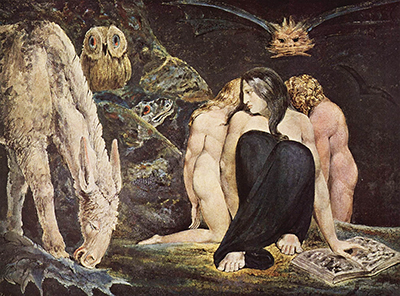The Night of Enitharmon's Joy by William Blake, which is sometimes known by the alternative title of The Triple Hecate or simply Hecate, depicts a character of Blake's own creation, seated at work on her magic, surrounded by her familiars.
The Night of Enitharmon's Joy was painted in 1795 using the materials of pen and ink with watercolour on paper. Although watercolour is often synonymous with the gentle, soft romanticism of the Romantic Period, here Blake uses watercolour for a totally different effect. The central character of Enitharmon stands out starkly against the whispering black of the darkness in the background, her sinuous physique and alabaster skin echoing Greek and Roman sculpture. The brush strokes give the bat's fur a tangible quality as he takes flight and the red eyes of the owl and the woolly mane of her donkey also contrast starkly against the overwhelming, dense blackness. The longer the painting is studied, the more details begin to emerge from the darkness.
Enitharmon is in fact a trio of characters, with a male and female outlined behind her, presumable emerging as she begins to read from her magical book in the foreground. The bat may have its wings, but its face is that of a cat and below the owl is another creature, not quite completed, that possibly echoes the head of a crocodile. The whole scene is both alluring and nightmarish in quality. A poet as well as a painter, William Blake created his own mythological anthology of characters, which he used to express his political and spiritual views which were rather unpopular during his lifetime.
His pro-American and French Revolutionary ideas and his anti-Church of England stance, despite his own Christian faith, made him seem rather kooky and on the outside when it came to his contemporaries. Blake was also much inspired by the paintings of Michelangelo, which may explain why Enitharmon appears to look so Romanesque, and a resurgence in popularity at the time of Shakespeare's tragedy Macbeth may have also inspired Blake to paint his Hecate as part of a three. It is also possible that the three Hecate inspiration comes from the Greek Three Fates, especially as Blake himself was so politically minded and motivated by changing the future.




